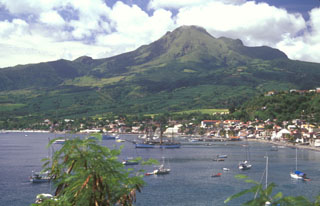Report on Pelee (France) — May 1986
Scientific Event Alert Network Bulletin, vol. 11, no. 5 (May 1986)
Managing Editor: Lindsay McClelland.
Pelee (France) Seismicity in 1929 crater
Please cite this report as:
Global Volcanism Program, 1986. Report on Pelee (France) (McClelland, L., ed.). Scientific Event Alert Network Bulletin, 11:5. Smithsonian Institution. https://doi.org/10.5479/si.GVP.SEAN198605-360120
Pelee
France
14.809°N, 61.166°W; summit elev. 1372 m
All times are local (unless otherwise noted)
Seismicity began on 11 December 1985, the first recorded since a well-implemented volcano monitoring network was installed in 1978. A constant low level of seismicity has been observed since December, totaling 30 events as of 4 June. Two 3-component stations were established for a month, helping to locate the shocks, at a constant depth of 1-1.5 km below the 1929 crater. Magnitudes were weak, all less than 2, and only a few were recorded at the Morne des Cadets observatory, 9 km SW of the epicentral area.
The seismic network is composed of five seismometers within 5 km of the summit. Seismic signals noted before the recent activity were attributed to surface phenomena such as rockfalls or local landslides.
Geological Summary. Montagne Pelée forms the northern end of the island of Martinique. Three major edifice failures since the late Pleistocene, the last about 9,000 years ago, have left large scarps open to the SW inside which the modern volcano has been constructed. More than 20 large eruptions have occurred here during the past 5,000 years. Extensive pyroclastic-flow deposits, incised by steep-walled ravines, mantle the slopes of the volcano. The l'Etang Sec summit crater is filled by two lava domes emplaced during the 1902 and 1929 eruptions. Moderate phreatic or phreatomagmatic eruptions in the Upper Rivière Claire valley were recorded in 1792 and 1851-52. The catastrophic 1902 eruption, which destroyed the city of St. Pierre, became the type-example of Pelean eruptions and marked the onset of modern volcanological studies of pyroclastic density currents.
Information Contacts: N. Girardin and A. Hirn, IPGP, France; G. Boudon and J.P. Viode, Observatoire Volcanologique de la Montagne Pelée, Martinique.

